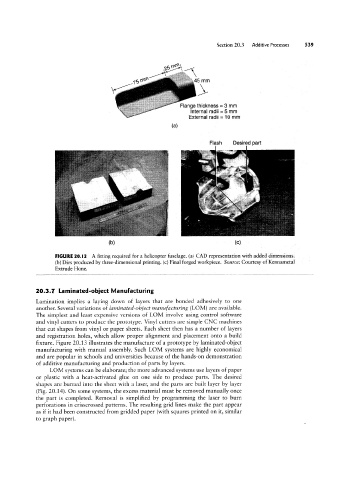Page 559 - 04. Subyek Engineering Materials - Manufacturing, Engineering and Technology SI 6th Edition - Serope Kalpakjian, Stephen Schmid (2009)
P. 559
Section 20.3 Additive Processes
45 mm
Flange thickness = 3 mm
internal radii = 5 mm
External radii = 10 mm
(6)
|-|,_»_ r\r_s.___|,___.;
(D) (C)
FIGURE 20.l2 A fitting required for a helicopter fuselage. (al CAD representation with added dimensions.
(b) Dies produced by three-dimensional printing. (c) Final forged workpiece. Source: Courtesy of Kennametal
Extrude Hone.
20.3.7 Laminated-object Manufacturing
Lamination implies a laying dovvn of layers that are bonded adhesively to one
another. Several variations of laminated-object manufacturing (LOM) are available.
The simplest and least expensive versions of LOM involve using control software
and vinyl cutters to produce the prototype. Vinyl cutters are simple CNC machines
that cut shapes from vinyl or paper sheets. Each sheet then has a number of layers
and registration holes, which allow proper alignment and placement onto a build
fixture. Figure 20.13 illustrates the manufacture of a prototype by laminated-object
manufacturing with manual assembly. Such LOM systems are highly economical
and are popular in schools and universities because of the hands-on demonstration
of additive manufacturing and production of parts by layers.
LOM systems can be elaborate; the more advanced systems use layers of paper
or plastic with a heat-activated glue on one side to produce parts. The desired
shapes are burned into the sheet with a laser, and the parts are built layer by layer
(Fig. 20.14). On some systems, the excess material must be removed manually once
the part is completed. Removal is simplified by programming the laser to burn
perforations in crisscrossed patterns. The resulting grid lines make the part appear
as if it had been constructed from gridded paper (With squares printed on it, similar
to graph paper).

